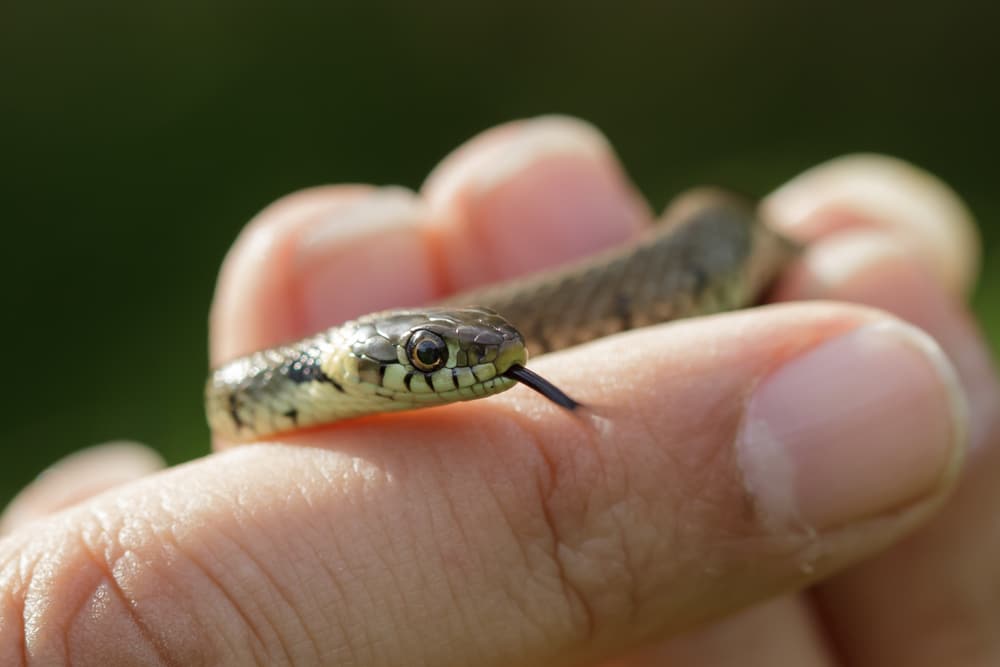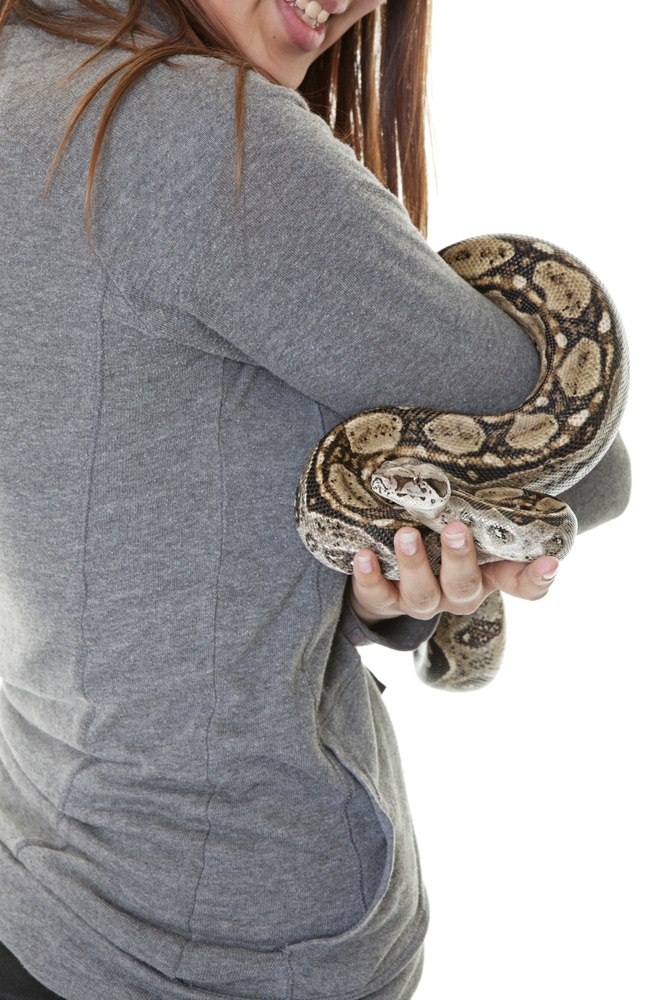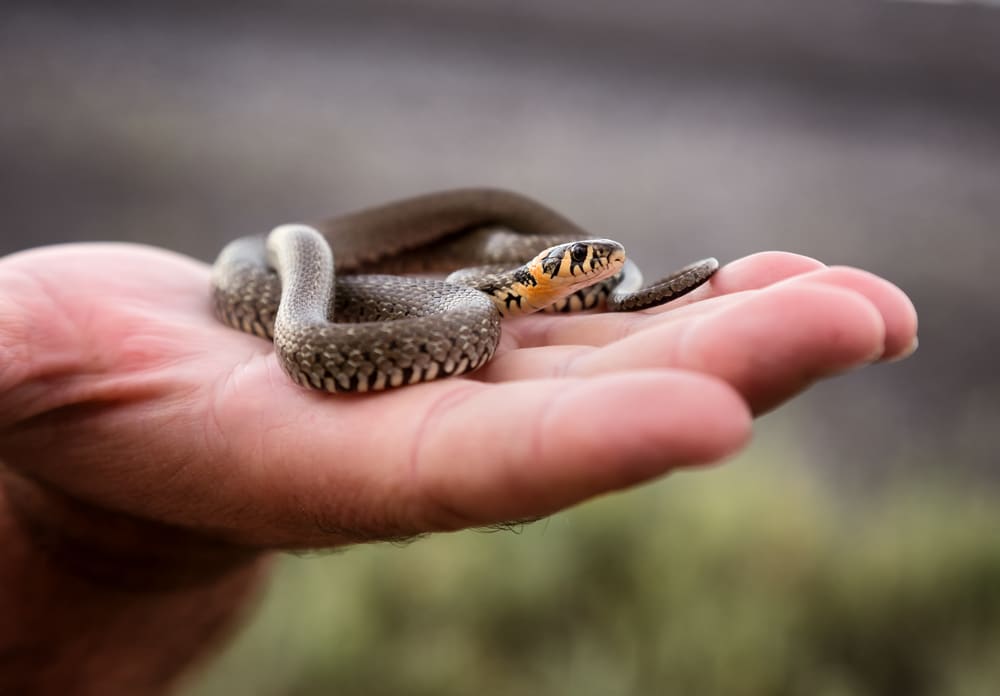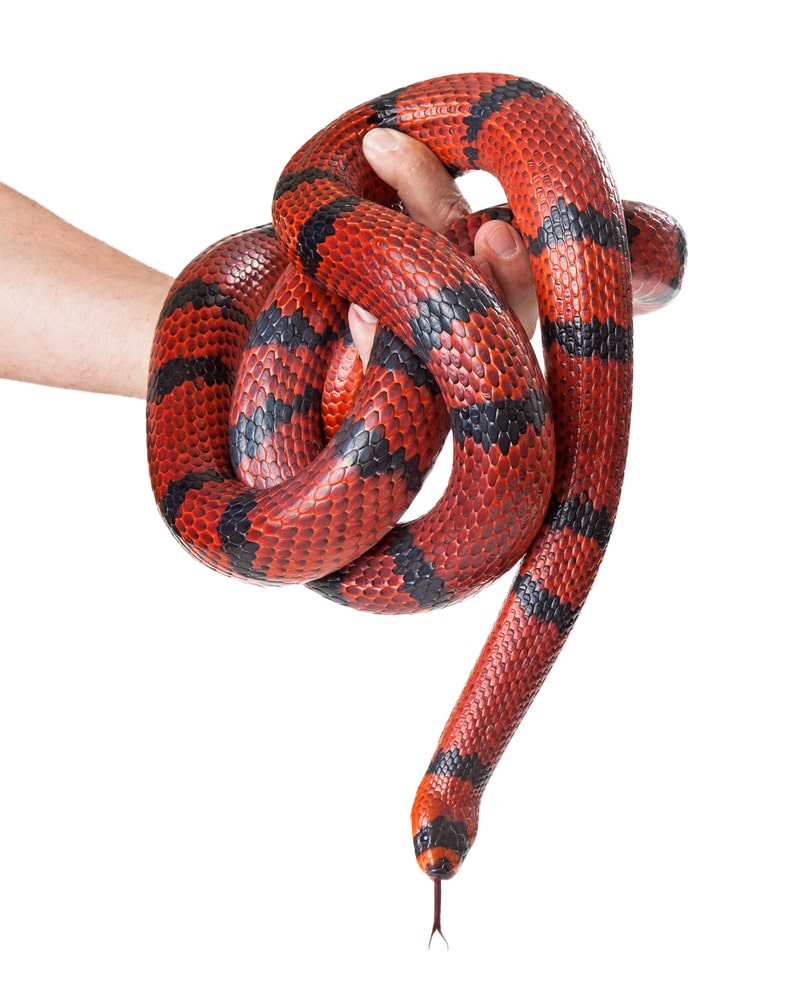Keepers have varying levels of interest in handling their pet snake.
Some enjoy this type of hands-on interaction greatly, while others rarely go out of their way to do so. Others do just about everything in their power to avoid handling their snake, often due to a fear of being bitten.
Nevertheless, if you have a pet snake, you’re going to have to handle it from time to time. Accordingly, it is imperative that all keepers learn the best possible way to do so – for the sake of you and your pet.

We’ll try to help you learn the best way to handle pet snakes below, which will not only reduce the chances that you’ll injure your pet or suffer a bite, but it’ll also improve your pet’s overall quality of life and allow you to interact more confidently with your snake.
Quick Navigation
General Advice: The Best Way to Handle a Pet Snake

Whenever setting out to handle your snake, you’ll want to begin by picking it up gently.
Typically, you’ll want to begin by gently grasping it at midbody with your fingers and lifting it slightly. As soon as possible, place your opposite hand underneath the snake to provide additional support.
Once the snake is in hand, your goal should simply be to support it, provide a comfortable place for the snake to crawl around and allow the animal to explore at its leisure. You don’t want to restrain it unless absolutely necessary, as this will invariably lead to stress and defensive behaviors.
Just understand that handling a pet snake is often a one-way street: While you may enjoy the activity, it is highly unlikely that your pet “enjoys” it too.
Many snakes will learn to tolerate regular handling and accept it as a normal part of life, but snakes aren’t social animals in the way dogs or cats may be. They don’t sit around in their habitat all day waiting for you to come and hold them.
How Often (and for How Long) Can You Handle a Pet Snake?

There are no hard-and-fast rules regarding the appropriate handling frequency or duration for pet snakes.
Some will tolerate several handling sessions per week and remain calm when handled for lengthy time periods, potentially lasting an hour or more.
Meanwhile, other snakes may become stressed anytime you put your hands on them and begin protesting this kind of keeper-snake interaction within minutes.
So, it is important to tailor your handling sessions to your snake’s needs and personality.
Your friend’s corn snake may not react poorly to frequent, long handling sessions, but yours may begin exhibiting signs of stress minutes after being removed from his enclosure. All snakes are individuals; as keepers, we must respect that.
With all of that said, most novice keepers should probably limit their handling sessions to once or twice per week, and each handling session should be relatively short – something along the lines of 10 to 15 minutes.
As you gain experience and learn how to interpret your snake’s body language better, you can slowly increase the frequency and duration of handling sessions.
Specific Snake-Handling Tips: Some Snakes Present Different Challenges Than Others

While there are a few aspects of snake handling that are consistent across a wide spectrum of species, there is a big difference between handling a 12-foot-long Burmese python and a 12-inch-long California kingsnake.
Snakes of different sizes require the keeper to embrace different techniques, and snakes of different ages and species often react differently during interactions.
We’ll try to share a few important tips for handling different types of snakes below.
Small Snakes
Small snakes (for our purposes here, we’ll define “small snakes” as being less than 2 feet long or so) are much more fragile than larger individuals, so you’ll need to be very gentle when handling them.
This can be tricky, as your fingers may be larger than the snake’s diameter, but it gets easier with practice.
Just try to employ the following tips and tricks when handling small snakes:
- If possible, try to encourage the snake to crawl into your hand or over your fingers instead of picking them up. This will reduce the chances that you’ll squeeze it excessively when trying to pick it up.
- Understand that small snakes heat up and cool off much more quickly than larger snakes do. This means you’ll want to keep handling sessions relatively brief. In warm temperatures, your hands may cause the snake’s body temperature to rise above comfortable levels; in cool temperatures, the snake may become dangerously chilled when surrounded by the relatively cold air in the room.
- Be especially careful with the head and neck region of small snakes, as well as the tail. Head or neck injuries can prove fatal (or so incapacitating that they’ll require you to have the snake euthanized), and tail injuries can leave a snake with permanently kinked tails.
Large Snakes
Large snakes (which we’ll define as those measuring more than 8 feet long) present a different set of challenges from small snakes.
While it is still possible to injure snakes of this size, the bigger concern is that the snake may injure you if it becomes defensive.
In the case of very large snakes, these injuries may be quite serious – in extreme cases, they could even prove fatal. Accordingly, you’ll want to embrace the following recommendations when handling large snakes:
- Always have a partner help when handling large snakes. This way, if the snake bites or constricts you, help will be available.
- Exercise good common sense when handling large snakes. If your snake seems more defensive than usual, or simply seems to be having a “bad day,” consider waiting to handle him for a day or so. This obviously isn’t always possible if you need to care for the animal, but non-essential handling sessions can always be rescheduled.
- Keep large snakes away from your face and throat if they aren’t known to be docile or trustworthy. Unfortunately, some snake species tend to aim defensive strikes at the face of perceived threats, so be careful to Similarly, you should avoid allowing large constrictors to wrap around your neck or chest.
- Always support large snakes sufficiently to prevent injuries. Supporting a large snake – particularly a heavy-bodied species – from a single place will put great strain on the nearby internal organs as well as the animal’s spine. So, be sure to use both arms and hands to provide as many points of support as possible for large snakes. It can also be helpful to use the ground or a table to support portions of the animal’s body.
In practice, snakes much longer than 8 to 10 feet are rarely easy for one person to handle.
You simply won’t have enough surface area to support such large snakes comfortably or safely.
This means that a partner is not only a good idea for safety, but also to help prevent injuries to the snake and ensure that it feels secure during the process.
Fast and Flighty Species
Typically, the easiest and most enjoyable snakes to handle are those who move relatively slowly. This includes a number of boas and pythons, as well as several colubrids, such as king, corn and rat snakes.
Nevertheless, there are plenty of other species that are popular among snake keepers, who tend to be faster and more active.
If you decide to keep these types of species, you’ll need to learn how to handle them for maintenance purposes, even if you don’t do so for your own enjoyment.
Unfortunately, there aren’t many helpful tips that we can share for handling these types of fast and flighty species – often, it simply takes practice. But you will want to keep a few things in mind:
- Generally, the best way to handle flighty snakes is by continually moving your hands by repeatedly placing one in front of the other. This way, the snake still gets to crawl forward, but you’ll be able to offer support and maintain some degree of control.
- Always try to handle flighty snakes while sitting on the floor or while holding them over a table. This will help limit the damage caused if they should fall during handling sessions.
- Whenever you must handle a flighty snake, it’ll often be easiest to do so when the snake is as cool and calm as possible. For diurnal species, you may want to try to do so at night, but you’ll often have better luck handling flighty nocturnal species early in the morning.
- Make every possible effort to keep handling sessions brief and trouble-free. Over time, many flighty snakes will calm down a bit, thereby making it easier to handle them. However, this requires that you build “trust” with the snake to keep its stress level low. Accordingly, you’ll want to be very gentle during all handling sessions and refrain from gripping the snake’s body if at all possible.
You may find that handling extremely flighty snakes (I’m looking at you, black racers and coachwhips), is best avoided completely.
In such cases, it will likely be more reasonable to simply encourage your snake to crawl into a small storage box or temporary enclosure, rather than physically putting your hands on it.
If you decide to take this approach, be sure to pick a transparent enclosure or box so that you can visually inspect your pet without having to touch him unnecessarily.
Picking Up Perched Snakes
If you like to keep green tree pythons, emerald tree boas or other arboreal species, you’ll need to use different techniques to handle your pet.
Most of these snakes like to spend long periods of time wrapped tightly around one or more tree branches, which can make extracting them from the enclosure difficult.
Just try to embrace the following tips and suggestions when handling perched snakes:
- Never try to “muscle” a snake from its perch. Forcefully prying a perched snake from a branch will often result in serious injuries to the animal. In some cases, this may include permanent spinal damage, which will force you to have your pet euthanized. Instead, try to gently encourage the snake to crawl off the perch willingly.
- Use removable perches whenever possible. Many experienced keepers and breeders provide arboreal species with removable climbing furniture and branches. This way, you needn’t remove your snake from a perch – you can simply remove the entire perch and place it in a temporary holding container while you inspect him or perform cage maintenance.
- Consider using a snake hook when handling arboreal species. Some arboreal species will be more comfortable crawling onto an inanimate object (such as a snake hook) than your outstretched hand. This is especially true of defensive individuals, who may view their keeper as a threat.
- Learn to “tickle” your snake when you need him to move. Gently stroking or tickling an arboreal snake will often trigger them to release their grip on the branch and start looking for somewhere else to hang out. If you learn to do so in a manner that doesn’t unnecessarily irritate or stress your snake, you’ll likely find that your snake accepts your arm or a snake hook as a new perch.
- Be extremely careful of the tails of arboreal species. Many arboreal snakes have very small, delicate tails that are easy to injure. This means you’ll not only need to be gentle when encouraging them to crawl off their perch but also while you’re holding them. In fact, it is generally advisable to avoid handling small arboreal species as much as possible.
Defensive Snakes
Unfortunately, some snakes are simply very defensive and will usually react to their keeper’s advances with hissing and strikes. They may also discharge copious amounts of musk, urates or feces once in hand.
These types of behaviors typically make handling sessions less than pleasant, but you’ll still need to handle your snake for husbandry and maintenance purposes.
Fortunately, there are plenty of things you can do to help reduce the chances of bites and help keep your snake’s stress level as low as possible.
- Most defensive snakes will react better to a snake hook than your hands. No one knows exactly why this is the case, but it likely relates to the temperature of the hook versus your hands. Being relatively warm, your hands scream “predator!” to a defensive snake, while a room-temperature snake hook doesn’t seem to trigger the same level of fear. Snake hooks also allow you to keep the snake farther away from your body, which will keep the snake calmer and reduce the chances of you being bitten or sprayed with fowl cloacal discharges.
- Consider covering the snake with a towel, blanket or sheet of newspaper before picking it up. If you must handle a defensive snake with your hands, it is typically easiest to do so by first covering the animal and then picking it up with the towel or blanket. Try to keep the animal contained and covered and move it into a temporary holding container as quickly as possible.
- To the extent possible, refrain from gripping the snake’s body. It is usually a good idea to avoid gripping any snake tightly but doing so with defensive animals will almost always escalate your pet’s stress level. In fact, gripping a snake’s body tightly is probably one of the most effective ways of eliciting defensive behaviors.
- Be decisive and act with purpose when picking up defensive snakes. Many keepers make the mistake of staring at a defensive animal for several minutes and trying to gather the nerve to open the enclosure door. This will often cause the snake to feel very threatened, and it’ll increase the odds of the animal reacting badly to your advances. Instead, walk up to the enclosure, open the door, and then pick up the snake quickly (even if you’re doing so with a hook or after covering it with a towel).
Aggressive Feeders
Some snakes may be relatively docile, yet still present challenges thanks to an overactive feeding response.
Such snakes are often fairly easy to handle once out of their enclosure – the problems occur when you reach in to pick them up.
Suddenly confronted with a warm, vaguely rodent-sized object, aggressive feeders may take the opportunity to strike at the perceived prey item.
This can be especially noteworthy because bites that result from feeding mistakes are often more serious than defensive bites.
Snakes who bite due to cases of mistaken identity often keep their teeth buried in the keeper’s skin, and they may also begin wrapping around the keeper’s arm in an effort to constrict the prey. So, these types of bites are usually even more important to avoid than defensive bites.
Fortunately, it is often pretty easy to do so – you just need to help the snake understand that you are not food. Among other things, this means you’ll want to:
- Gently tap or knock on the enclosure before opening it. This will often help wake up the snake if he is sleeping, which will reduce the chances of catching him by surprise and give him the chance to understand that you’re about to pick him up.
- Touch the snake gently yet firmly at mid-body if it is safe to do so. As with tapping the enclosure, touching your snake at midbody will often help him to understand that you are not food. Just be sure that it is safe to do so – especially if the snake in question is large.
- Tap the snake on the nose with a soft object (such as the handle of a snake hook) if he advances. If your efforts to distinguish yourself from food aren’t successful, and the snake begins moving toward you, try gently tapping him on the nose with something soft. This will often discourage hunting or feeding behaviors.
- Always be sure to avoid smelling like potential prey when reaching into the enclosure. Remember: Snakes primarily identify their prey via their sense of smell, so be sure that you wash your hands after handling rodents, birds or other pets before you stick your hands in the enclosure. You’ll also need to take similar steps after handling lizards or other snakes if you maintain a reptile-eating species, such as a kingsnake.
Don’t Forget About Hygiene
In addition to keeping your snake comfortable and all parties safe when handling your pet, you must also keep hygiene in mind.
Snakes are fairly clean pets, but they (as well as most other reptiles) can carry Salmonella bacteria. They needn’t even exhibit symptoms to be harboring the bacteria – they’re often asymptomatic carriers.
This means that you’ll want to do a few things anytime you’re handling your pet:
- Wash your hands after handling your snake. Just get into the habit of washing your hands with soap and warm water after every handling session, and you’ll drastically reduce the chances of falling ill.
- Wash your hands after handling any enclosure furniture, husbandry tools or similar items. Just like your snake, anything that comes into contact with him or his enclosure may become contaminated with bacteria. Additionally, it is a good idea to wash husbandry tools after each use.
- Don’t allow your snake to crawl on surfaces where foods are stored, prepared or consumed. In general, you should refrain from even bringing your snake into the kitchen but be sure that you don’t allow him to crawl on your kitchen counter, dining room table, or kitchen sink.
- Avoid allowing young children, the elderly or immunocompromised individuals to touch your pet. Healthy adults can become sick from Salmonella, but vulnerable groups are at far greater risk.
The chances of contracting Salmonella from a snake are likely lower than they would be from some other reptiles (such as aquatic turtles), but it’s still wise to be cautious.
Conclusion
We hope you’ve found this snake-handling guide helpful, and that you can enjoy more confidence after reviewing the information provided above.
Just try to implement the tips, tricks and guidelines we’ve shared and always keep your snake’s well-being at the forefront of your mind.